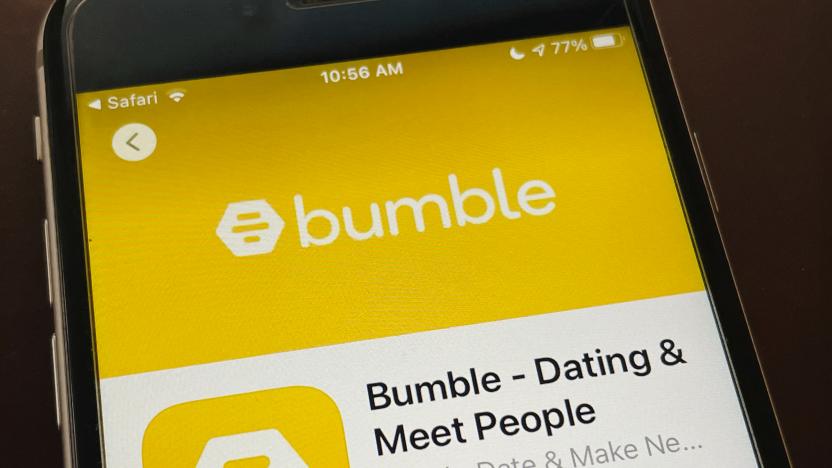ghosting
Latest

Bumble tackles no-shows for IRL dates with its updated community guidelines
Bumble is trying to make its apps safe spaces for meeting new people and that extends to real-life meetups. The latest community guidelines take aim at ghosting or people failing to turn up for pre-arranged meetups. The latest policies also tackle bots, promotion of OnlyFans pages and victim blaming.

A Filipino politician wants to make ghosting a criminal offense
Dude, just go to therapy.

Coffee Meets Bagel dating app is trying to end ghosting
"Coffee Meets Bagel," a dating app that promises high-quality matches, has launched a rather pricey premium tier. The company's cofounder told VentureBeat that they had a lofty goal in mind when they decided to offer the option: they want to end ghosting. The habit is one of the most prevalent issues with services like this, and in an effort to combat the problem, dating apps are turning more and more like the older dating sites they replaced. Coffee Meets Bagel is but the latest one to launch a premium option -- its rivals, including Tinder, also offer similar tiers of their own.

Ghosting redefined
They are our brothers and sisters, our mothers and fathers, our teachers, our students, our bankers, our janitors, the bathroom attendant, the perfume-counter girl, the porn star, the preacher. They are the right-wing nut job, the Left Shark and the guy in the middle seat. There's no discernible difference between us and them. In fact, there's a good chance you're one of them. They are ghosts -- or so we've been told.

Switched On: The old adventures of new 3D
Each week Ross Rubin contributes Switched On, a column about consumer technology. In the unmarked office of 3-D Vision, Inc., you can see a television or PC display a videogame or movie with a convincing stereoscopic effect. That might not seem very unique. However, the television is a CRT from the 1990s, the video game is Super Mario for the Nintendo 64 and the movie is The Wizard of Oz, made in 1939. Despite the growth in 3D television sales, the requirement to wear 3D glasses has loomed as one of the most significant barriers to adoption. 3-D Vision's technology still requires glasses, at least for now. However, with some caveats, it overcomes some of the other, oft-overlooked barriers to 3D adoption by creating 3D video from 2D content on 2D (or 3D) displays. On televisions, this is achieved via a small set-top box -- a prototype of which approaches the size and noise level of a mini-fridge -- that plugs into the video source and the TV and converts the video in real-time with virtually no latency. The box should be available early next year.

Halo: Reach beta visually dissected by Digital Foundry
Well, we knew it was bound to happen sooner or later, right? First things first: Yes, Halo: Reach is apparently running at a full 720p according to Digital Foundry's review of the beta thus far (so many Ps!). And, like Halo 3 before it, the Reach beta achieves a near constant 30 frames-per-second of highly frenetic gameplay, albeit dropping a few every now and then during, um ... explosive situations (let us once again remind you that the game is still in beta). In fact, aside from the occasional screen tear and a bit of a "ghosting" issue ("frame bending" -- two or more images being blurred together -- can sometimes result in objects on screen not appearing solid, as seen in this image), DF is quite impressed with the beta's visual presentation, not to mention the gameplay. The three pages on the beta go into far more detail than we've dropped into this post, and, well, we've got a lot more Reach to play, so we'd encourage you to read more right here.

New glasses-free 3D tech uses per pixel prisms for zero crosstalk, audience flexibility
Try as manufacturers might, attempts at autostereoscopic (glasses-free) TV have been subpar; existing tech typically makes for messy images due to ghosting, only provides a 3D effect if you're standing in one of a very few predetermined spots (usually 8-10 viewing angles, though we've heard of 64), and reduces display resolution -- all because only some pixels can be seen from each spot. With the occasional exception, it's not terribly impressive. Scientists at the National Chiao Tung University in Taiwan are looking to change that. Rather than block light with a parallax barrier, their screen uses a matrix of specially cut prisms to reflect it, reducing ghosting to nil and maintaining display resolution by sending the same image to each viewer. Though there are still a fixed number of viewing zones, the prisms are so tiny that manufacturers can simply add more prisms to each pixel to increase that number -- with 11 prisms per pixel, researchers say such a system could support 100 simultaneous 3D moviegoers. We've no word on whether the tech is affordable or when we'll see it, but we expect it to handily beat cyborg eyeballs to market.



